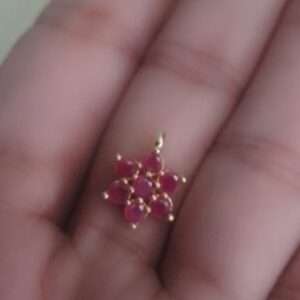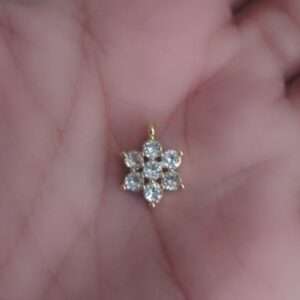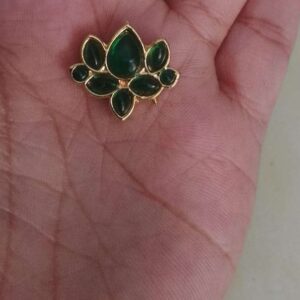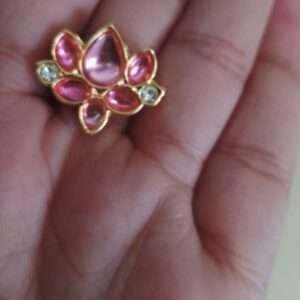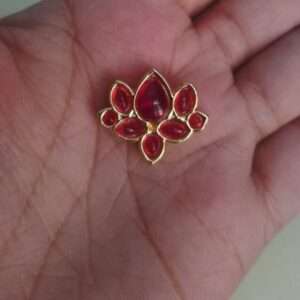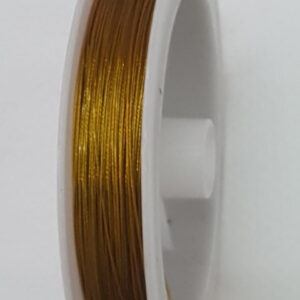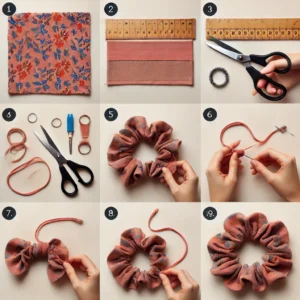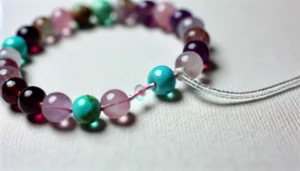Home » Posts tagged '#CraftIdeas'
Tag Archives: #CraftIdeas
DIY Silk Thread Necklace: Step-by-Step Tutorial with Pictures
A silk thread necklace is an elegant and affordable alternative to gold or stone jewellery. Handmade silk thread necklaces are perfect for festive occasions, weddings, and ethnic outfits.
In this step-by-step guide, you’ll learn how to create a beautiful silk thread necklace using simple materials at home.
Why Make a Handmade Silk Thread Necklace?



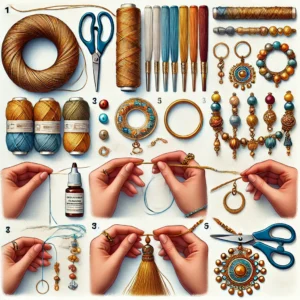
Materials Needed:
- Silk thread (colour of your choice)
- Necklace cord or thick wire (for the base)
- Threaded beads (gold, pearl, or coloured)
- Fabric glue or Fevicol
- Scissors
- Hook clasps (for securing the necklace)
Step-by-Step Process
Step 1: Prepare the Base
- Cut a necklace cord or thick wire to the desired length (15-18 inches).
- Apply a thin layer of glue and start wrapping silk thread tightly around the wire.
- Ensure the thread is evenly wrapped for a smooth look.
Step 2: String the Beads
- Once the thread wrapping is complete, start threading beads onto the necklace.
- Arrange them in a pattern (e.g., alternating colours or sizes).
- Add spacers or small pearls between large beads for a designer look.
Step 3: Securing the Ends
- Use hook clasps at both ends of the necklace to secure it.
- Apply glue inside the clasp area for extra durability.
- Allow it to dry completely for at least 4-5 hours before wearing.
Step 4: Final Touches & Wearing
- Check for any loose beads and secure them with extra glue if needed.
- Pair your handmade silk thread necklace with matching earrings or bangles for a complete look.
Expert Tips for a Professional Finish



How to make handmade silk thread jhumkas (earrings) – A beginner’s guide
Silk thread jhumkas are a timeless fashion accessory that complements both traditional and contemporary outfits. Making them at home allows you to experiment with colours, designs, and embellishments to match your style.
This step-by-step guide will walk you through making silk thread jhumkas using simple materials.
Why Make Your Own Silk Thread Jhumkas?



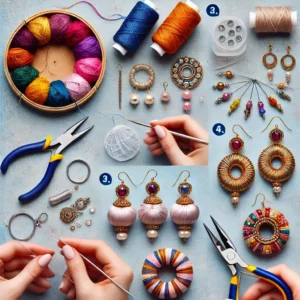
Materials Needed:
- Silk thread (any colour)
- Plastic or wooden jhumka base (available online or in craft stores)
- Fabric glue or Fevicol
- Earring hooks and headpins
- Scissors
- Decorative beads, stones, or gold chains
Step-by-Step Process
Step 1: Wrapping the Jhumka Base
- Take a plastic or wooden jhumka base.
- Apply a thin layer of fabric glue evenly across the base.
- Start wrapping silk thread tightly around the base.
- Ensure there are no gaps between the thread layers for a polished look.
Step 2: Attaching the Earring Hook
- Use a thin headpin to pierce through the top centre of the jhumka base.
- Slide a small bead onto the pin for extra decoration.
- Attach the earring hook by bending the headpin into a loop using pliers.
Step 3: Adding Decorative Elements
- Glue small beads, pearls, or golden chains around the jhumka’s edge.
- Use a toothpick to apply glue carefully for neatness.
- Arrange beads symmetrically for a professional finish.
Step 4: Let It Dry & Wear
- Allow the earrings to dry completely for at least 3-4 hours.
- Your beautiful handmade silk thread jhumkas are now ready to wear!
Expert Tips for Perfect Silk Thread Jhumkas



Step-by-Step guide to making silk thread bangles at home
Silk thread bangles are a beautiful and affordable alternative to traditional gold and glass bangles. Their vibrant colours and intricate designs make them a perfect accessory for ethnic and festive wear. In this guide, you’ll learn how to make silk thread bangles at home with simple materials and creative designs.
Why Choose Handmade Silk Thread Bangles?
- Budget-friendly – Costs much less than gold or metal bangles.
- Customisable – Choose colours, patterns, and decorations.
- Lightweight & Comfortable – No risk of breakage like glass bangles.
- Materials Needed:
- Plain plastic or metal bangles (any size)
- Silk thread in your preferred colours
- Fevicol or fabric glue
- Toothpicks or glue brush for even application
- Scissors
- Small decorative stones, beads, or pearls
Step-by-Step Process

Step 1: Prepare the Bangle Base
- Choose a sturdy bangle (plastic or metal).
- If using multiple bangles together, stick them using strong glue and let them dry.
- Apply a thin layer of Fevicol or fabric glue in small sections for easy handling.
Step 2: Wrapping the Silk Thread
- Tie one end of the silk thread inside the bangle to secure it.
- Begin wrapping the silk thread tightly and evenly around the bangle.
- Use toothpicks to spread the glue as you wrap, ensuring a smooth finish.
Step 3: Securing the Ends
- Once fully wrapped, apply glue to the last part of the thread.
- Press it gently and hold for a few seconds to let it dry.
Step 4: Adding Decorations
- Use small beads, pearls, or decorative stones to embellish the bangle.
- Arrange them in patterns or as a single line for a designer look.
- Use a toothpick to apply glue and carefully place each stone.
Step 5: Let It Dry & Wear
- Allow the bangles to dry completely for a few hours before using them.
- Pair them with matching outfits for a stylish ethnic look.
Tips for Making Perfect Silk Thread Bangles
- Use double layers of thread for a richer, fuller look.
- Mix two colours for a dual-tone effect.
- Try zigzag wrapping for a unique design.
- Add hanging beads or charms for an exclusive touch.
DIY Terracotta Jewelry: Unleash Your Creativity with These Easy Step-by-Step Images!
Learn how to make terracotta jewelry with our step-by-step guide. Discover the materials needed, tips, and tricks to create beautiful, sustainable pieces at home.
Terracotta jewelry, known for its earthy and rustic charm, is becoming a popular choice among DIY enthusiasts and fashion lovers alike. This handcrafted jewelry, made from natural clay, can be customized in endless designs, making it both unique and sustainable. If you’re looking to create your own terracotta jewelry, this guide will take you through the process step-by-step, complete with images to help you craft stunning pieces right at home.
What You Need to Get Started
Before diving into the steps, gather these essential materials:
- Terracotta clay (available in art supply stores)
- Rolling pin or clay roller
- Cookie cutters or any small mold for shaping
- Sandpaper
- Water and sponge
- Paints (acrylic or fabric paints)
- Paintbrushes
- Jewelry findings (hooks, earring posts, chains, etc.)
- Needle or pin for making holes
- Clear varnish or glaze for finishing
Step-by-Step Process to Make Terracotta Jewelry
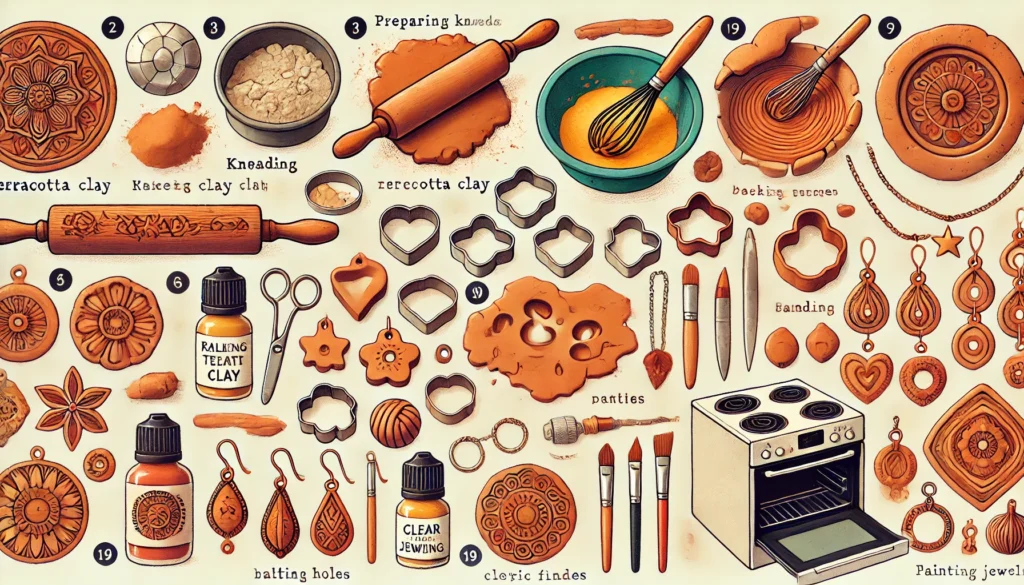
Step 1: Prepare the Clay
To start, take a small amount of terracotta clay and knead it well. Ensure there are no air bubbles, as they can cause cracks during the baking process. The clay should be soft and pliable. If it’s too dry, add a few drops of water and knead again.
Step 2: Roll Out the Clay
Using a rolling pin or clay roller, flatten the clay to your desired thickness—typically around 3 to 5 mm. This thickness ensures that the jewelry pieces are sturdy yet not too heavy to wear.
Step 3: Cut Out Shapes
Use cookie cutters, molds, or a knife to cut out shapes from the rolled-out clay. Popular shapes for terracotta jewelry include circles, squares, leaves, and geometric patterns. If you want to add more intricate designs, use a needle or a carving tool to create patterns on the surface of the clay.
Step 4: Make Holes for Findings
Using a needle or pin, carefully poke holes where you want to attach hooks, chains, or other findings. Ensure the holes are big enough to accommodate your jewelry findings but not too large that they compromise the structure of the clay.
Step 5: Smooth the Edges
Gently smooth the edges of each piece with a damp sponge or your fingers. This will help give a more polished and refined look to the final product. Let the pieces dry for a bit before moving on to the next step.
Step 6: Bake the Clay
Preheat your oven to 220°F (104°C). Place the clay pieces on a baking tray lined with parchment paper and bake for 30-40 minutes. Baking time may vary depending on the size and thickness of your pieces, so keep an eye on them. Once baked, let them cool completely before handling.
Step 7: Sand and Refine
Once the pieces are baked and cooled, use fine-grit sandpaper to smooth out any rough edges or surfaces. This step is crucial for giving your jewelry a professional finish.
Step 8: Paint Your Jewelry
Now comes the fun part—painting! Use acrylic or fabric paints to decorate your jewelry pieces. You can choose traditional designs or contemporary patterns, depending on your style preference. Allow the paint to dry completely.
Step 9: Apply a Varnish
To seal the paint and give the jewelry a shiny finish, apply a layer of clear varnish or glaze. This step also makes the jewelry water-resistant and more durable.
Step 10: Assemble the Jewelry
Attach hooks, chains, and other findings to your jewelry pieces using the holes made earlier. Use pliers to securely attach these findings, ensuring your jewelry is both functional and beautiful.
Step 11: Enjoy Your Handmade Terracotta Jewelry!
Congratulations! You’ve now created your very own terracotta jewelry. Whether it’s a pair of earrings, a necklace, or a bracelet, these handmade pieces are perfect for any occasion and make great gifts too.
Tips for Making Terracotta Jewelry
- Experiment with different shapes, sizes, and colors to create a diverse collection.
- If you’re new to painting, start with simple designs and gradually work your way up to more intricate patterns.
- Always wear a mask when sanding the baked clay to avoid inhaling any dust.
Conclusion
Making terracotta jewelry at home is a fun, creative, and eco-friendly activity that allows you to express your artistic side. With this step-by-step guide and a bit of practice, you’ll be crafting beautiful, unique jewelry pieces in no time!
